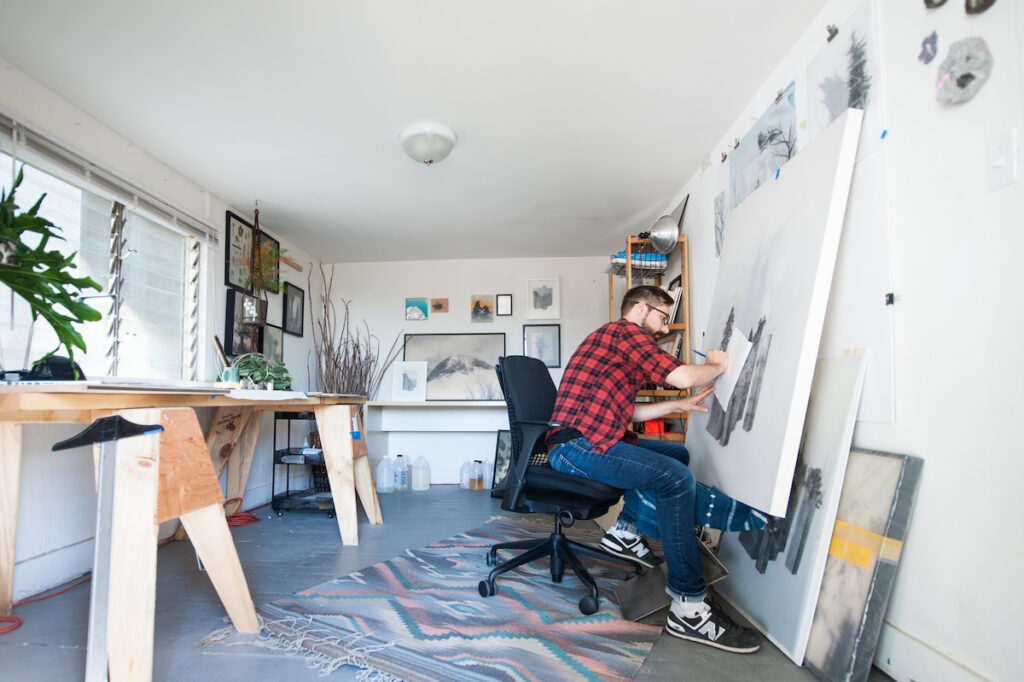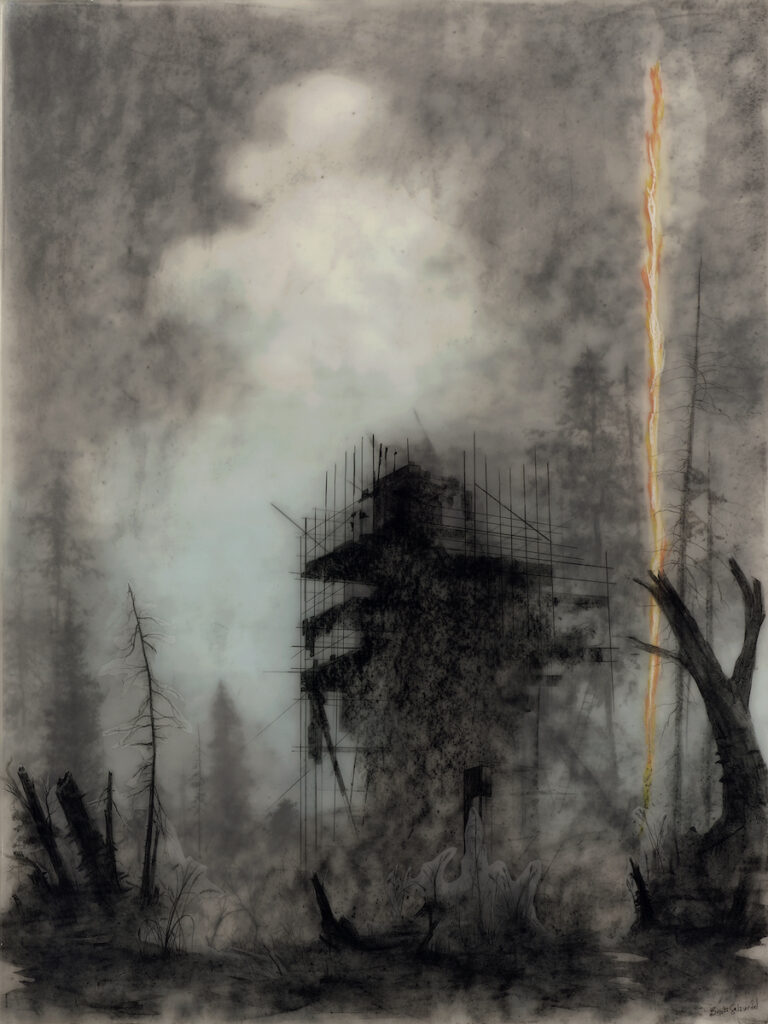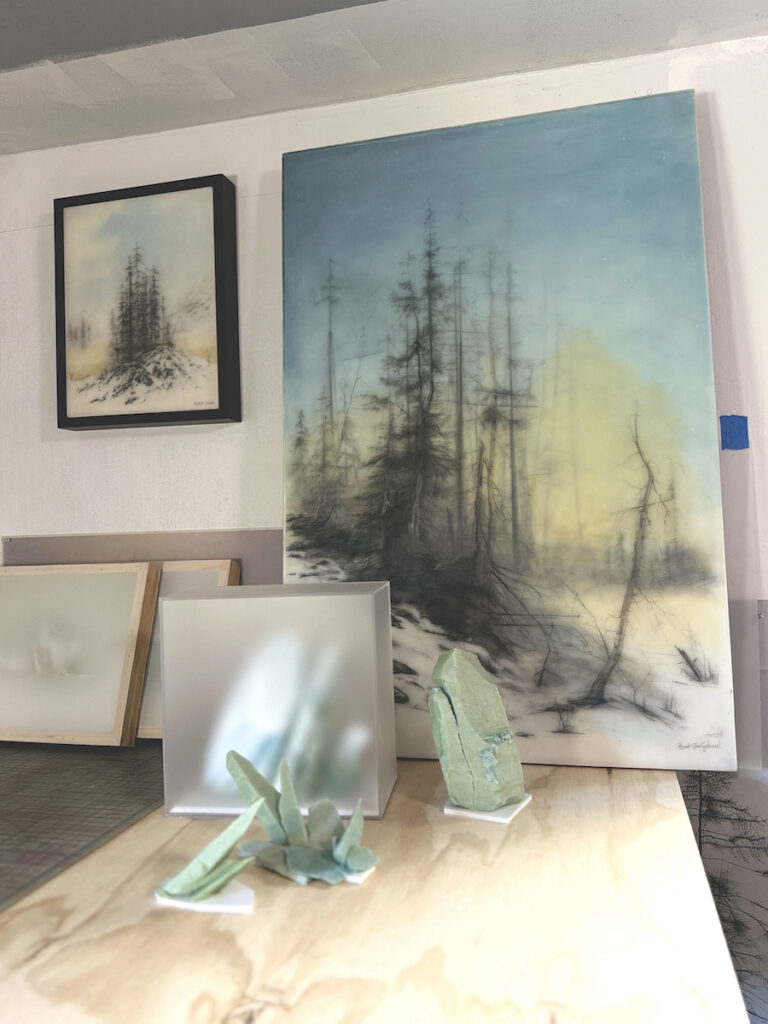Who doesn’t love looking at images of a working artist’s studio? We hosted a fantastic Instagram Live with Secret Garden artist Brooks Shane Salzwedel from his studio in Los Angeles (it’s posted on our Instagram page). We also wanted to offer a static way to share looks into his artist studio. His answers to our questions were very informative and soulful. Please enjoy!

Does the imagery in your work stem from places you visit or your imagination?
The natural imagery in my work started from my imagination, particularly of forested places intertwined with personal events. Over time, I began incorporating real places inspired by hikes and trips. This evolution from imagined to real places, specifically, National Parks led to my residencies in Denali in Alaska and White River National Park in Aspen, CO, further enriching my landscapes.

Do you work from photos?
Yes, I predominantly work from photos, often blending elements from different photos into a single piece and improvising the rest as I progress.
How long have you been using the process you developed?
I began experimenting with different processes during my last term at Art Center. It took a couple of years to perfect my technique, which has come to be known as The Brooks Salzwedel Technique. I continuously explore different types of semi-transparent materials to achieve atmospheric quality, using wax, double-sided adhesive sheets, glues, paint mediums, acrylic, glass, and more.

What draws you to nature?
Nature has always held a significant place in my life. If I hadn’t pursued art, I would have likely ventured into botany, wildlife conservation, or geology. My connection to nature and urban development in my work stems from my father taking my brother and I camping before he died when I was five-years-old. One of my few memories of him is camping with my family, fueling my deep connection to nature.

Is the concern for the environment important in your work?
There is an underlying environmental message in my work addressing pollutants from offshore drilling and corporate greed. My father died while working on a drill ship. A typhoon capsized the drill ship while in the South China Sea. The oil company my father worked for ignored warnings about the danger of leaving the ship at sea, leading to the death of 84 workers. This tragedy often manifests in my work through a pollutant-like yellow ochre hue, oil derrick, broken fuselage, and more.
Do you include personal elements in your work?
While personal elements in my earlier work were more overt, they are now more subtle or represented across the entire series. For instance, a series based on walking city parks in Los Angeles at night explores feelings of isolation and fear, even in seemingly safer environments.

Each of your pieces seem to hold a mystery through not only the haunting landscapes but also with the reoccurring images hidden amongst the trees.
Hidden within the trees and brush one will find oil rigs, fire pits, pills, rainbows, logos, planes, and other various, carefully placed images which make the pieces personal, playful and create a greater narrative when linked together.

We notice the work as an intentional play with scale. For example, in *Bridges Weeds*, here at the gallery, the weeds are disproportionate to the pine tree. This is intentionally done to create an interplay between the familiar and the imagined landscape, which challenges the relationship between place and meaning. Is this correct?
Yes! That’s exactly what it is. It gives me more room for imagination and plays on textures and details that wouldn’t been seen in some of my other pieces.

With your tins, you are clearly taking depictions of vast landscapes and containing them in confined spaces which gives us a desolate feeling and a space for rumination. In your larger 2D art, it seems you are doing the same, however rather than tins, you have confined the landscape in your created architectural structures. Can you please explain this use of architectural elements in your work?
Though the imagery in the tins is remote, sometimes barren they are also more precious and create an intimate feel; a large world that goes beyond the boundaries of the tin edges. The larger works usually start with the landscape; the trees or forest that I want to focus on then hide structures within them creating the conflict of nature overtaking manmade objects or man-made objects being forced into a natural setting with some confusion of it being the past or a future.



Recent Comments